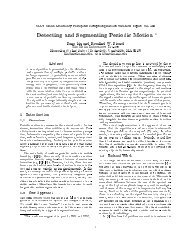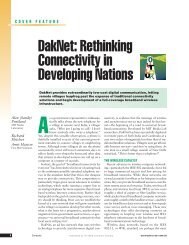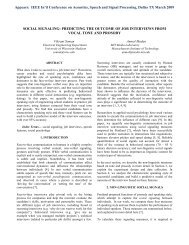Social Serendipity: Proximity Sensing and Cueing - Human ...
Social Serendipity: Proximity Sensing and Cueing - Human ...
Social Serendipity: Proximity Sensing and Cueing - Human ...
Create successful ePaper yourself
Turn your PDF publications into a flip-book with our unique Google optimized e-Paper software.
2 Previous Work: <strong>Social</strong> <strong>Proximity</strong> <strong>Sensing</strong> <strong>and</strong> <strong>Social</strong> Software<br />
We are continually aided by desktops, laptops, h<strong>and</strong>held computers <strong>and</strong> mobile<br />
phones, yet these innovations were primarily designed to empower the individual.<br />
However, over the last decade there have been many instantiations of both social proximity<br />
sensing as well as social software. Below is by no means a comprehensive review,<br />
but rather a sample of the diverse projects in this burgeoning field.<br />
2.1 <strong>Social</strong> <strong>Proximity</strong> <strong>Sensing</strong><br />
<strong>Human</strong> proximity sensing systems are traditionally associated with a machine-human<br />
interface incorporating technologies such as IR motion sensors or machine vision.<br />
However such sensing systems can only function in a fixed or limited area. In contrast,<br />
social proximity sensing has almost always involved wearable devices that can detect<br />
other proximate people. Over the last decade there have been many instantiations of<br />
social proximity sensing, from badges to keychain electronics.<br />
Badges<br />
Although primarily used for location-based applications, electronic badges 1 can also<br />
sense social proximity. The exposed manner in which they are worn allows line-ofsight<br />
sensors, such as infrared (IR), to detect face-to-face interactions. They have been<br />
primarily used in conferences <strong>and</strong> within the office environment.<br />
Office Environment. Office buildings within research labs are popularly used to test<br />
these badge systems <strong>and</strong> conduct social science experiments due to the cooperative<br />
nature of the people in the labs.<br />
The ActiveBadge / ParcTab / Bat. Initially developed over fifteen years ago as a<br />
technology to enable telephone systems to route calls to an individual's current location,<br />
there have now been many experiments tracking people at the office place using<br />
electronic badges. Recent developments in ultrasound tracking have greatly improved<br />
the ability to localize the badge, enabling a wide range of just-in-time information<br />
applications [15, 13, 1].<br />
Sociometer. The sociometer is a wearable computer that can accurately infer a person's<br />
interactions with others in face-to-face conversations, allowing inference of social<br />
influence <strong>and</strong> status [2].<br />
1<br />
a broad term that, in this instance, implies a device worn overtly over the clothes in plain<br />
view.






